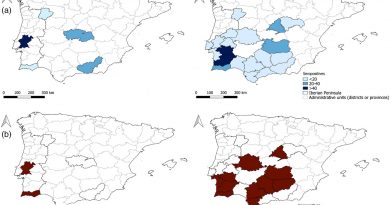Dirofilaria immitis in pet dogs from the metropolitan area of the Colombian Caribbean
Comparative Immunology, Microbiology and Infectious Diseases
Abstract
A cross-sectional study was carried out to determine the frequency and factors associated with Dirofilaria immitis infection in pet dogs in the metropolitan area of the Colombian Caribbean (northern Colombia). A total of 173 dogs were analyzed by a commercial rapid immunochromatographic test (RIT) and a nested PCR of the cytochrome oxidase subunit I gene, in parallel. Ninety-two (53.2%) of the dogs showed positive results to the RIT, while 59 (34.1%) animals had D. immitis DNA by PCR. Positivity to one or both diagnostic techniques was detected in 104 (60.1%; CI95%: 53.8–67.4) of the sampled dogs. In PCR-positive dogs, phylogenetic analyses evidenced high nucleotide identity (100%) with sequences previously obtained from mosquitoes, dogs and other mammals in different countries. Exercise intolerance (p = 0.002; OR: 2.33; CI95%: 1.37–3.96) and thrombocytopenia (p = < 0.001; OR: 1.95; CI95%: 1.11–3.43) were the main factors associated with D. immitis infection in dogs. The high frequency of D. immitis in dogs indicates a wide distribution of this parasite in the metropolitan area of the Colombian Caribbean, which can be of animal and public health concern. Our results highlight the need to combine different methods to increase the diagnostic accuracy of D. immitis.




